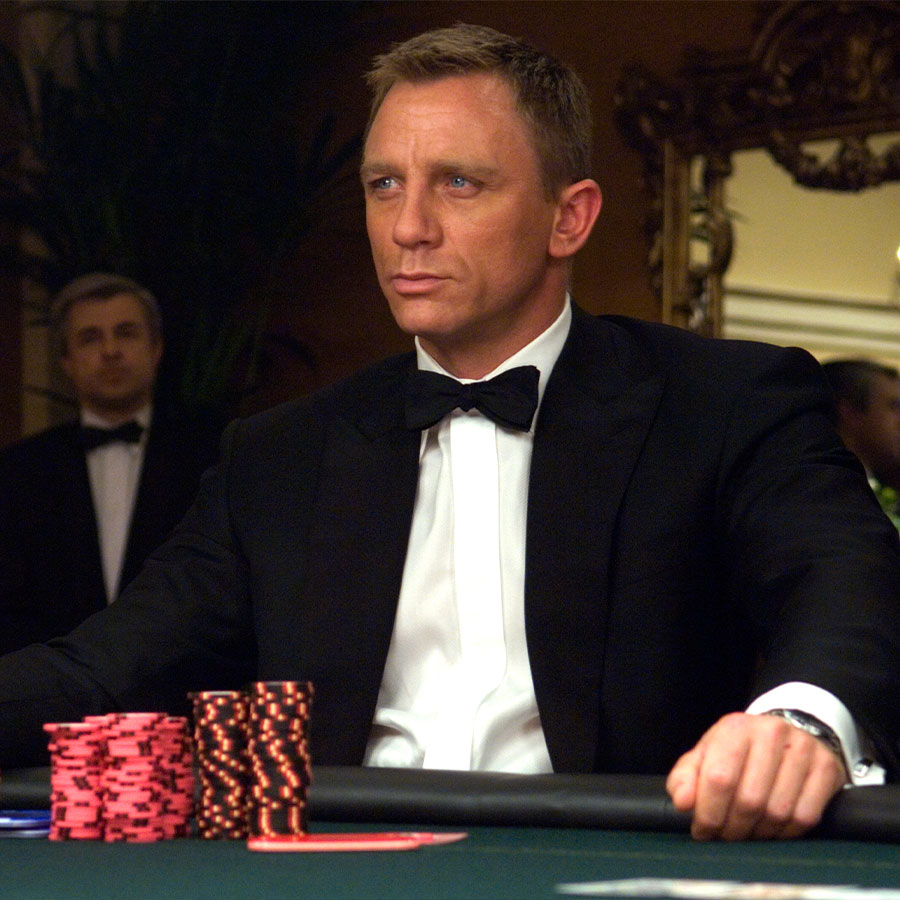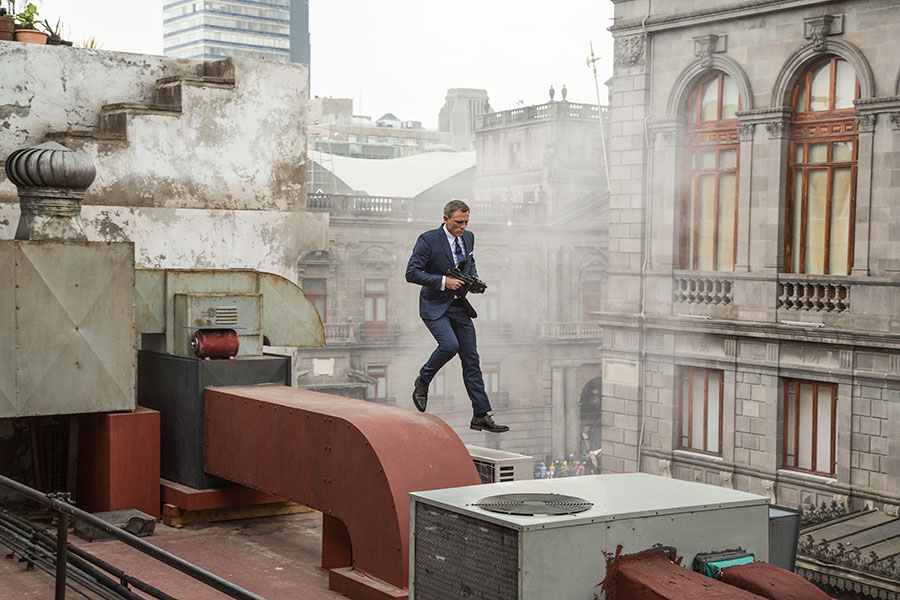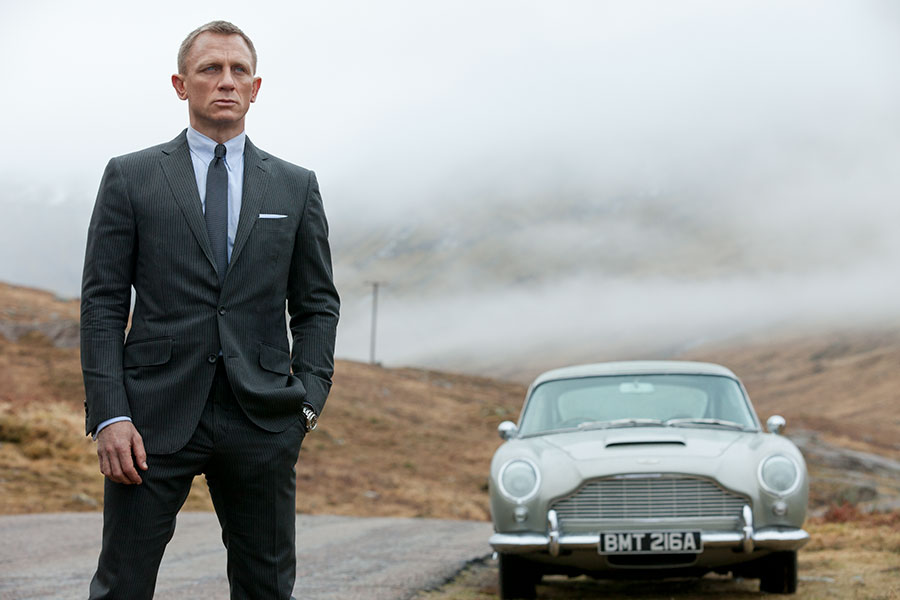James Bond For a Modern World: 5 Ways the 007 Character Continues to Evolve

Daniel Craig outfitted like classic James Bond in his debut as 007 in the 2006 film 'Casino Royale.' Photo: Metro-Goldwyn Mayer Pictures and Columbia Pictures through Sony Pictures Releasing
The world is very different today than when Sean Connery first introduced himself as “Bond. James Bond” in his 1962 debut, Dr. No. As the 25th film in the franchise, No Time to Die is set to open in theatres October 8 after being delayed three times by the pandemic, it’s also to be Daniel Craig’s final outing in the role after 15 years.
There are, of course, so many things to love about Bond — the devilish grin, the masterful tuxes, the cool theme songs, the creepy villains, the camp one-liners, the traditional opening sequence that culminates with Bond walking into the frame and turning to shoot a bullet down a barrel — causing blood to cascade over the camera. Every new Bond film is an event: the producers make us wait between drops — unlike, say, the Marvel franchise, which feels relentlessly ubiquitous.
But there are elements of Bond that are, well, just not modern. It was in 2001, after the 9/11 attacks, that Bond’s producers first realized the character had to change with the times; the old, Cold War-style villains (and reflexive racism) of the Fleming novels that served as source material for the series were outdated. As Barbara Broccoli, the daughter of original producer Albert “Cubby” Broccoli, told GQ of the morning of 9/11, when they were working on Die Another Day: “We felt the world has changed and the nature of these films has to change.”
The #MeToo movement that began in 2017 brought another reckoning, as scenes of Bond’s many love ‘em and leave ‘em amorous conquests suddenly felt less comfortable (and less consensual, at times; also, um, the hitting of women no longer plays so well).
The movies have each also become less of a standalone property. The Bonds of Sean Connery, George Lazenby, Roger Moore, Timothy Dalton and Pierce Brosnan remained frozen in a single timeline; one actor would leave the franchise and the next would pick up the mantle seamlessly in the next outing, in the manner of a soap opera replacement.
Daniel Craig’s Bond, by contrast, has gone through an arc, as the stories told over his five Bond films are serialized. He has a conflicted inner life, he has aged, loved, lost and mourned. This looking at the WHY of Bond’s behaviour is all new, and Craig himself told GQ that he found something new to relate to in Fleming’s books: Bond in print was a “cold, messed up, human. He’s kind of a f*ck up. Because this job would f*ck you up.”
There are, of course, still the elements of camp in the films that we all gobble up like popcorn: the beautiful women (though they, too, now have some substance, and are not the automatic cannon fodder; time was, any Bond girl with a line of dialogue was automatically doomed), tuxes and martinis and shoot outs and nifty gadgets from quartermaster Q, the epic chase scenes and villains with world domination ambitions to thwart. And the Bond series is still a massive success (Craig’s five films alone made $3 billion with him in the driver’s seat of the Aston Martin.) But that said, there is also still lots of room for the modernization of the franchise going forward.
The Anachronisms
The Bond franchise is known for sassy — and looking back, now terrifically inappropriate — one-liners of a sexual or racist nature. Live and Let Die was knocked for Blaxploitation. In Dr. No, Bond famously asks the Black character Quarrel to “fetch my shoes.” Then there was the time, in You Only Live Twice, while Bond was being soaped up by a bevy of Japanese beauties, that Tiger Tanaka said: “You know what it is about you that fascinates them. It’s the hair on your chest. Japanese men all have beautiful bare skin.” Bond’s retort? “Bird never make nest in bare tree.”
Charlie Higson — a producer on No Time to Die who also writes the Young Bond young adult novel series — reflected to Britain’s Radio Times about how Bond has changed.
“Would the original Bond survive in our modern world, or would cancel culture succeed where Spectre has failed so often and finish him off for good?” He goes on to add, “He’d be able to mansplain the correct temperature that champagne should be served at, but he’d be all at sea trying to negotiate the correct use of pronouns.”

Higson is being sarcastic here, sure, but the question does need to be asked: If the producers, writers and actors had not begun to shift the Bond universe into more progressive territory, would the whole back catalogue die off like the dinosaurs?
See, if Bond continues to grow a conscience (and grow as a human), there’s a chance we can still enjoy the old films as naughty relics of a bygone age. If Bond didn’t (and doesn’t continue to) evolve, the corny/offensive throwbacks might become untenable to modern audiences. Making Bond woke could salvage the whole back catalogue from being “cancelled.”
Ultimately, the point is that being the epitome of male-kind is a responsibility these days, and Bond needs to carry our expectations on his wide, sexy shoulders.
The Fashion
Bond girls, beginning with the iconic Ursula Andress arising from the sea like Venus in a white bikini in Dr. No, are, by definition, scantily dressed. It is only with the rise of more fully fleshed out female characters in the recent movies that they get to wear real clothes.
James Bond basically pivots between a Saville Row tailored tuxedo to swim trunks (with the unforgettable moment Sean Connery wore a blue terry cloth playsuit onesie in Goldfinger!).
Today we have more equal opportunity ogling. In Daniel Craig’s debut, he shared bathing suit duties with Halle Berry, both of them exiting the surf in teeny weenies: Bond in a blue micro short that threw back to Connery’s best ocean exploits; Berry in an orange model with a dive knife tucked in at the hip.
The tuxedo is also inextricably linked with Bond. Over the years, a number of famous tailors put their stamp on 007’s dinner wear, from Anthony Sinclair of Saville Row, who outfitted Connery, to Cyril Castle, also of Saville Row, who dressed Roger Moore (later followed by Angelo Roma, who gave Bond a distinctly 70s vibe; and Douglas Hayward, who rescued Bond from the perils of 80s fashion by ignoring 80s fashion).
Style took a back seat to the toys and cars in the Pierce Brosnan era, but came surging back with Daniel Craig who, of course, is dressed impeccably by the incomparable Tom Ford.
As a postscript: there is a whole internet tribe devoted to Bond ski fashions over the years, but that is kind of a niche fashion interest.
So do we want Bond’s fashion sense to change? Look at how Daniel Craig showed up to the movie’s London premiere in a pink velvet tux from the Saville Row tailor Anderson & Sheppard. Pretty progressive stuff, that! If the bastion of tradition in the London fashion world is changing with the times, it begs the question: should Bond look different on the outside now he’s starting to possess different values on the inside?
I’d argue that because Bond has an element of comic book to the cannon — all the campy, fun stuff — one of the reason’s Bond has lasted 60 years is that he has stayed true to his image. Take the classic black and white tux out of Bond and you lose that instantly recognizable brand. Plus, in our increasingly casual world, tuxedos provide an instant sense of glamour and elegance is in such short supply.
Not that Craig didn’t look fantastic on the red carpet in hot pink: but going there onscreen would be like Q giving him a Nerf gun instead of a rocket missile.
The Pickup Lines
We waver on our favourite cheesy one-liners — some of which didn’t-age-well — over the years. If you look at the series as a kind of time capsule, it feels less icky to laugh in all the wrong places.
Take Denise Richards, who played nuclear physicist Christmas Jones opposite Pierce Brosnan in The World is Not Enough. Waking up beside her, Bond takes the too-obvious joke, “I thought Christmas only comes once a year!”
And, in case you forgot, Madonna made an appearance as a fencing instructor in the franchise, delivering this gem to Brosnan’s Bond in Die Another Day: “I see you handle your weapon well.” To which he replies, “I’ve been known to keep my tip up.”
Perhaps, though, the creepiest line came from Roger Moore in For Your Eyes Only, when he instructed his (much younger) paramour: “Now put your clothes back on and I’ll buy you an ice cream.”
Daniel Craig himself explained to Man’s World of India why he thinks women like Bond. “He’s dangerous. It’s as simple as that.”
Still, you can see how the writers became more careful of how Craig’s Bond spoke to women with this quote from Skyfall, where he is explicit about himself, rather than his conquest. In the shower with Severine (played by Bérénice Marlohe), she tells him: “I like you better without your Beretta.” He replies, “I feel naked without it.”
No Time to Die is the first Bond film post-#MeToo, as his last outing, Spectre, hit screens in 2015, ahead of the culture-shaking social justice movement. So far, the lineup of strong women, with agency and substance, in No Time to Die leaves us hopeful that Bond writers will take more care moving forward.
Don’t get me wrong, I think one-liners and cheesy pickup lines are a critical element here, but there is a way to do them without demeaning half the globe. One would think Phoebe Waller-Bridge, in her role as script doctor on No Time to Die, probably had a hand in fine tuning the quick-fire commentary.
The Gadgets and the Cars
The legendary Q (played most memorably by Desmond Llewelyn, but also by John Cleese and, most recently, in a younger version by Ben Whishaw) was always warning Bond, to no avail, not to wreck his clever devices while he outfitted him for a mission.
From the crocodile submarine to the tea tray that cuts off heads, the gadgets are a big part of the Bond allure. A personal favourite was the boom box that Timothy Dalton (the often overlooked Bond) got from Q that launched missiles. (That film, The Living Daylights, also featured a couch that swallows people.) Pierce Brosnan also hid a missile inside a leg cast in GoldenEye.
Tech advances in the real world have almost caught up to the cool gadgets Bond has used over time. Finding exciting and novel ways to kill villains is part of the eternal fun of the franchise, but with so much cool tech constantly emerging in real life, Q will have to come up with some even crazier devices to keep up the thrill factor going forward.
The new Q, Ben Whishaw, is much younger than the previous Qs, and is very much a computer nerd whiz kid. That contrasts with Bond who, to date, has not shown much digital savvy. And any electronic plot elements take place outside of Bond’s purview. He remains the action guy — another element that it would be a shame to meddle with. The rest of Bond’s world can be wired, but Bond as bareknuckle fighter is a good kind of throwback.
Of course, the most important gadget in Bond world is his car. The Aston Martin DB5 is the most famous Bond car by far; it wasn’t the only car Bond drove, but it is the one we all remember and covet. It wasn’t until 1964’s Goldfinger that Sean Connery first alighted from the sexy, British-made sports car. It came specially equipped with machine guns, spikes for slashing tires and an ejection seat.

The Aston Martin DBS showed up again in On Her Majesty’s Secret Service (1969) and, later, juiced up with missiles in Diamonds Are Forever (1971). An Aston Martin V8 popped up in the 1987 flick The Living Daylights while the DB5 returned for GoldenEye (1995) and Tomorrow Never Dies (in 1997 — but only briefly because, then, we were in the 90s, the era when BMW was paying to place cars in Bond films).
The DB series was brought back with Daniel Craig in 2008’s Casino Royale, where Bond flips his DBS V12 to save Vesper, whom Le Chiffre has tied to the road.
As with Bond’s fashion, I’d argue against overly modernizing the Bond fleet. How often do we get to ogle Aston Martin’s in real life? It is a legacy fantasy car, after all.
And seeing Craig whiz around the corner of a winding road on a fog-swept Scottish moor in Skyfall gave the same frisson as Connery wielding the wheel of his DB5 through the Furka Pass in Switzerland in Goldfinger. Sure, he could have a Tesla in his garage as well — a nod to a more environmentally-conscious Bond — but that would have to be a second ride.
Craig’s Legacy and the Next James Bond
For many of us, Sean Connery’s Bond is so iconic (and unmatched) because he could walk the line between camp and cool with such unruffled aplomb.
As evidence, take this, from the opening sequence of Goldfinger: Bond rises up out of the ocean, disguised with a fake bird on his head, while on a mission to blow up a drug lab — which he does without breaking a sweat. Taking off his wetsuit, we are treated to a full, white tuxedo underneath. He lights a smoke and smirks. Except for the cigarette, of course, this scene captures what we will always love about James Bond, whoever plays the iconic role: the insouciance of it all!
As Daniel Craig said in a statement after Connery’s death: “He defined an era and a style. The wit and charm he portrayed onscreen could be measured in megawatt; he helped create the modern blockbuster.”
Daniel Craig was reviled by the British (and some international press) when he was chosen for the part: a blond Bond! Egads! Thankfully, for his sake, the internet of haters hadn’t yet developed into the full-blown toxic mire it is today, though he previously admitted that, upon being cast as Bond, he had been psyched out by the hate: “I know why they don’t like me. I know why I don’t like me. So I know why they don’t f*cking like me.” But once the opening sequence rolled at the premiere of Casino Royale, even Craig could relax.
Modern audiences, in fact, liked Craig because his humanity showed in a way the wry, smirking, devil-may-care, indestructible Bond of Connery (or Lazenby, or Moore or Dalton or Brosnan) never did. Craig’s Bond could be injured, physically and emotionally.
But in the end, Craig fit his era’s Bond as perfectly as a tailored tuxedo. Craig, and the Broccolis (Cubby’s stepson, Michael G. Wilson, co-produces the franchise), have shepherded 007 through to the modern world and ensured much of the problematic aspects to the Bond legacy have been course corrected.
So then, who’s up next? British writing/acting/showrunning phenom Phoebe Waller-Bridge (Fleabag, Killing Eve), who was brought in, at Craig’s request, as a script doctor on No Time to Die, was asked on the red carpet of the film’s starry world premiere at London’s Royal Albert Hall if Bond should be a woman. “I think Bond is James Bond,” she answered. “We just need to cook up someone to rival him.”
Craig seconded that with the carpet quote: “Why should a woman play James Bond when there should be a part just as good as James Bond, but for a woman?”

Indeed, the new movie shows some improvement for female-kind: Bond’s love is a returning character, as Lea Seydoux plays Dr. Madeleine Swann. Lashana Lynch joins the cast as the first female, and first Black 00 agent; she has been given Bond’s license to kill designation in his absence. Naomie Harris returns as Moneypenny — the secretary no longer a sexist, cardboard-cutout mooning unrequitedly after Bond. And Ana de Armas plays an operative in a Havana scene.
Fan chatter is buzzing about a number of great candidates to don Bond’s tux, from Idris Elba (my personal all-time fave, for what it’s worth) to Tom Hardy.
Whoever takes up the mantle will no doubt suffer the slings and arrows of intense fan interest and differing ideas of how to keep a 60-year long story going. But with all the guns and girls and toys and snazzy clothes, the next Bond will have a lot of help fitting in.
RELATED:
No Time to Die: Tracing the History of James Bond in Jamaica as 007 Makes His Return to the Island
Farewell James Bond: How Daniel Craig’s 15-Year Run as 007 Helped Reinvent the Character